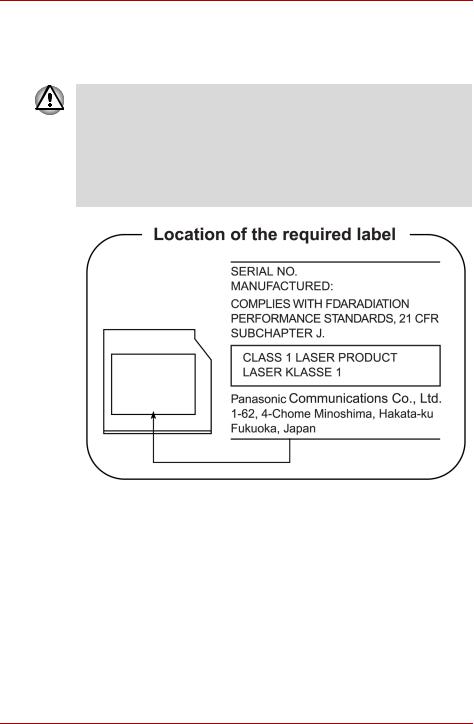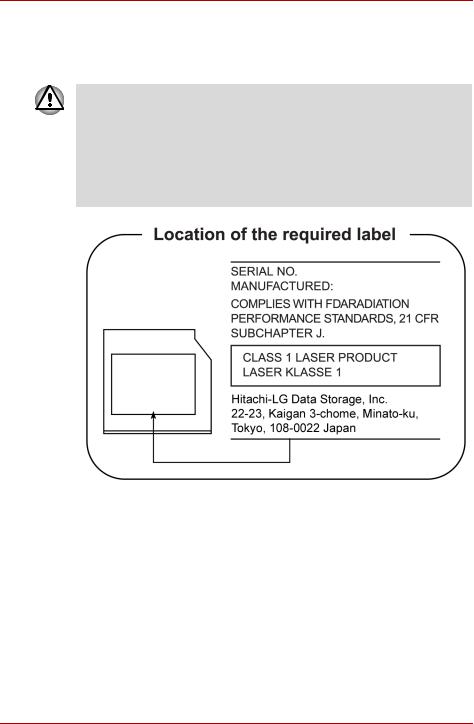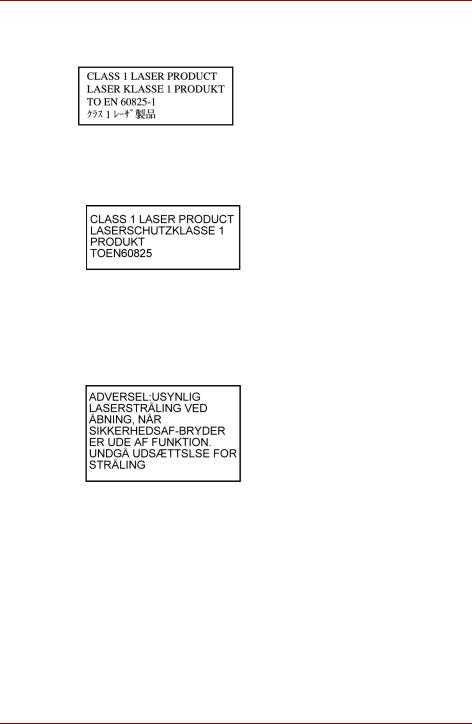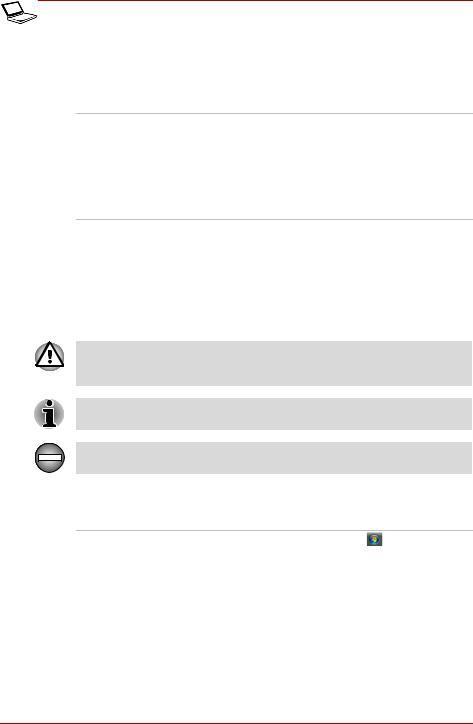Toshiba M800 User Manual

User’s Manual
Portégé M800
computers.toshiba-europe.com

Portégé M800
Copyright
© 2008 by TOSHIBA Corporation. All rights reserved. Under the copyright laws, this manual cannot be reproduced in any form without the prior written permission of TOSHIBA. No patent liability is assumed, with respect to the use of the information contained herein.
TOSHIBA Portégé M800 Portable Personal Computer User's Manual
First edition March 2008
Ownership and copyright of music, video, computer programs, databases, etc. are protected by the copyright laws. These copyrighted materials may be copied for private use at home only. If, beyond the limitation above, you copy (including to transform data formats) or modify these materials, transfer them or distribute them via the Internet without approval of copyright owners, you may be subject to claims for compensation for damage and/or criminal penalties due to infringements of copyrights or personal rights. Please remember to observe the copyright laws when you use this product to copy the copyrighted works or perform other actions.
Please note that you may infringe the owner's rights protected by the copyright laws if you use the screen mode switching functions (e.g. Wide mode, Wide Zoom mode, etc.) of this product to display enlarged images/ video at coffee shops or hotels for the purposes of profits or providing these to the public.
Disclaimer
This manual has been validated and reviewed for accuracy. The instructions and descriptions it contains are accurate for the TOSHIBA Portégé M800 Portable Personal Computer at the time of this manual’s production. However, succeeding computers and manuals are subject to change without notice. TOSHIBA assumes no liability for damages incurred directly or indirectly from errors, omissions or discrepancies between the computer and the manual.
Trademarks
Microsoft, Windows and Windows Vista are either registered trademarks or trademarks of Microsoft Corporation.
DirectX, AcriveDesktop, DirectShow, and Windows Media are registered trademarks of Microsoft Corporation.
Intel, Intel Core, Celeron, Centrino and Pentium are trademarks or registered trademarks of Intel Corporation.
Adobe and Photoshop are either registered trademarks or trademarks of Adobe Systems Incorporated.
Bluetooth™ is a registered trademark owned by its proprietor and used by TOSHIBA under license.
ConfigFree is a trademark of TOSHIBA Corporation. DVD MovieFactory is a trademark of Ulead Systems. Inc.
User’s Manual |
ii |

Portégé M800
BizCard is a trademark of NewSoft Technology Corporation. Dolby is a registered trademark of Dolby Laboratories. ExpressCard is a trademark of PCMCIA.
HDMI, the HDMI logo and High-Definition Multimedia Interface are trademarks or registered trademarks of HDMI Licensing LLC.
Labelflash™ is a trademark of YAMAHA CORPORATION.
Memory Stick, Memory Stick PRO, and i.LINK are registered trademarks and i.LINK is a trademark of Sony Corporation.
MultiMediaCard and MMC are trademarks of MultiMediaCard Association. Photo CD is a trademark of Eastman Kodak.
Secure Digital and SD are trademarks of SD Card Association. xD-Picture Card is a trademark of Fuji Photo Film, Co., Ltd. Wi-Fi is a registered trademark of the Wi-Fi Alliance.
Other trademarks and registered trademarks not listed above may be used in this manual.
Safety Instructions
Use the following safety guidelines to help protect yourself and your computer.
When Using Your Computer
Do not operate your portable computer for an extended period of time with the base resting directly on your body. With extended operation, heat can potentially build up in the base. Allowing sustained contact with the skin could cause discomfort or, eventually, a burn.
■Do not attempt to service the computer yourself. Always follow installation instructions closely.
■Do not carry a battery in your pocket, purse, or other container where metal objects (such as car keys) could short-circuit the battery terminals. The resulting excessive current follow can cause extremely high temperatures and may result in damage from burns.
■Be sure that noting rests on your AC adapter’s power cable and that the cable is not located where it can be tripped over or stepped on.
■Place the AC adapter in a ventilated area, such as a desk top or on the floor, when you use it to run the computer or to charge the battery. Do not cover the AC adapter with papers or other items that will reduce cooling; also, do not use the AC adapter while it is inside a carrying case.
■Use only the AC adapter and batteries that are approved for use with this computer. Use of another type of battery or AC adapter may risk fire or explosion.
User’s Manual |
iii |

Portégé M800
■Before you connect the computer to a power source, ensure that the voltage rating of the AC adapter matches that of the available power source. 115 V/ 60 Hz in most of North and South America and some Far Eastern countries such as Taiwan. 100 V/50 Hz in eastern Japan and 100 V/60 Hz in western Japan. 230 V/50 Hz in most of Europe, the Middle East, and the Far East.
■If you use an extension cable with your AC adapter, ensure that the total ampere rating of the products plugged in to the extension cable does not exceed the ampere rating of the extension cable.
■To remove power from the computer, turn it off, remove the battery, and disconnect the AC adapter from the electrical outlet.
■To help avoid the potential hazard of electric shock, do not connect or disconnect any cables or perform maintenance or reconfiguration of this product during and electrical storm.
■When setting up the computer for work, place it on a level surface.
EU Declaration of Conformity
This product is labelled with the CE Mark in accordance with Radio Equipment and Telecommunications Terminal Equipment Directive 1999/5/ EC which includes the compliance to the Electromagnetic Compatibility Directive 2004/108/EC and the Low Voltage Directive 2006/95/EC.
CE Marking is the responsibility of TOSHIBA EUROPE GmbH, Hammfelddamm 8, 41460 Neuss, Germany, phone +49-(0)-2131-158-01.
For a copy of the related CE Declaration of Conformity please refer to thefollowing website: http://epps.toshiba-teg.com
This product and the supplied accessories are designed to observe the required EMC (Electromagnetic Compatibility) standards. However, Toshiba cannot guarantee that this product still observes these EMC standards if accessories or cables not manufactured/distributed by Toshiba are connected or implemented. To avoid in general EMC problems, the following advice should be observed:
■Only CE marked accessories should be connected/implemented
■Only the best shielded data cables should be connected
GOST
User’s Manual |
iv |

Portégé M800
Modem warning notice
Conformity Statement
The equipment has been approved to [Council Decision 98/482/EC - "TBR 21"] for pan-European single terminal connection to the Public Switched Telephone Network (PSTN).
However, due to differences between the individual PSTNs provided in different countries/regions the approval does not, of itself, give an unconditional assurance of successful operation on every PSTN network termination point.
In the event of problems, you should contact your equipment supplier in the first instance.
Network Compatibility Statement
This product is designed to work with, and is compatible with the following networks. It has been tested to and found to conform with the additional requirements conditional in EG 201 121.
Germany |
ATAAB AN005, AN006, AN007, AN009, AN010 and |
|
DE03, 04, 05, 08, 09,12,14,17 |
Greece |
ATAAB AN005, AN006 and GR01, 02, 03, 04 |
|
|
Portugal |
ATAAB AN001, 005, 006, 007, 011 and P03, 04, 08, |
|
10 |
Spain |
ATAAB AN005, 007, 012, and ES01 |
|
|
Switzerland |
ATAAB AN002 |
|
|
All other countries/ |
ATAAB AN003, 004 |
regions |
|
Specific switch settings or software setup are required for each network, please refer to the relevant sections of the user guide for more details.
The hookflash (timed break register recall) function is subject to separate national type approvals. It has not been tested for conformity to national type regulations, and no guarantee of successful operation of that specific function on specific national networks can be given.
Following information is only for EU-member states:
The symbol indicates that this product may not be treated as household waste. Please ensure this product is properly disposed as inappropriate waste handling of this product may cause potential hazards to the environment and human health. For more detailed information about recycling of this product, please contact your local city office, your household waste disposal service or the shop where you purchased the product.
User’s Manual |
v |

Portégé M800
This symbol may not stick depending on the country and region where you purchased.
EnergyStar® Program
Your computer model may be Energy Star® Compliant. If the model you purchased is compliant, it is labeled with the ENERGY STAR logo on the computer and the following information applies.
TOSHIBA is a partner in the Environmental Protection Agency’s (EPA) ENERGY STAR® Program and has designed this computer to meet the latest ENERGY STAR® guidelines for energy efficiency. Your computer ships with the power management options preset to a configuration that will provide the most stable operating environment and optimum system performance for both AC power and battery modes.
To conserve energy, your computer is set to enter the low-power Sleep mode which shuts down the system and display within 15 minutes of inactivity in AC power mode. TOSHIBA recommends that you leave this and other energy saving features active, so that your computer will operate at its maximum energy efficiency. You can wake the computer from Sleep mode by pressing the power button.
Products that earn the ENERGY STAR® prevent greenhouse gas emissions by meeting strict energy efficiency guidelines set by the US EPA and the EU Commission. According to the EPA, a computer meeting the new ENERGY STAR® specifications will use between 20% and 50% less energy depending on how it is used. Visit http://www.eu-energystar.org or http://www.energystar.gov for more information regarding the ENERGY STAR Program.
Optical disc drive safety instructions
Be sure to check the international precautions at the end of this section.
User’s Manual |
vi |

Portégé M800
Panasonic
DVD Super Multi UJ-862B/862F
■ The DVD Super Multi drive employs a laser system. To ensure proper use of this product, please read this instruction manual carefully and retain for future reference. Should the unit ever require maintenance, contact an authorized service location.
■Use of controls, adjustments or the performance of procedures other than those specified may result in hazardous radiation exposure.
■To prevent direct exposure to the laser beam, do not try to open the enclosure.
User’s Manual |
vii |

Portégé M800
Hitach-LG Data Storage
DVD Super Multi GSA-U10N/10F
■ The DVD Super Multi drive employs a laser system. To ensure proper use of this product, please read this instruction manual carefully and retain for future reference. Should the unit ever require maintenance, contact an authorized service location.
■Use of controls, adjustments or the performance of procedures other than those specified may result in hazardous radiation exposure.
■To prevent direct exposure to the laser beam, do not try to open the enclosure.
User’s Manual |
viii |

Portégé M800
International Precautions
CAUTION: This appliance contains a laser system and is classified as a "CLASS 1 LASER PRODUCT." To use this model properly, read the instruction manual carefully and keep this manual for your future reference. In case of any trouble with this model, please contact your nearest "AUTHORIZED service station." To prevent direct exposure to the laser beam, do not try to open the enclosure.
VORSICHT: Dieses Gerät enthält ein Laser-System und ist als "LASERSCHUTZKLASSE 1 PRODUKT" klassifiziert. Für den richtigen Gebrauch dieses Modells lesen Sie bitte die Bedienungsanleitung sorgfältig durch und bewahren diese bitte als Referenz auf. Falls Probleme mit diesem Modell auftreten, benachrichtigen Sie bitte die nächste "autorisierte Service-Vertretung". Um einen direkten Kontakt mit dem Laserstrahl zu vermeiden darf das Gerät nicht geöffnet werden.
ADVARSEL: Denne mærking er anbragt udvendigt på apparatet og indikerer, at apparatet arbejder med laserstråler af klasse 1, hviket betyder, at der anvendes laserstrlier af svageste klasse, og at man ikke på apparatets yderside kan bilve udsat for utilladellg kraftig stråling.
APPARATET BOR KUN ÅBNES AF FAGFOLK MED SÆRLIGT KENDSKAB TIL APPARATER MED LASERSTRÅLER!
Indvendigt i apparatet er anbragt den her gengivne advarselsmækning, som advarer imod at foretage sådanne indgreb i apparatet, at man kan komme til at udsatte sig for laserstråling.
User’s Manual |
ix |

Portégé M800
OBS! Apparaten innehåller laserkomponent som avger laserstråining överstigande gränsen för laserklass 1.
VAROITUS. Suojakoteloa si saa avata. Laite sisältää laserdiodin, joka lähetää näkymätöntä silmilie vaarallista lasersäteilyä.
CAUTION: USE OF CONTROLS OR ADJUSTMENTS OR PERFORMANCE OF PROCEDURES OTHER THAN THOSE SPECIFIED IN THE OWNER’S MANUAL MAY RESULT IN HAZARDOUS RADIATION EXPOSURE.
VORSICHT: DIE VERWENDUNG VON ANDEREN STEURUNGEN ODER EINSTELLUNGEN ODER DAS DURCHFÜHREN VON ANDEREN VORGÄNGEN ALS IN DER BEDIENUNGSANLEITUNG BESCHRIEBEN KÖNNEN GEFÄHRLICHE STRAHLENEXPOSITIONEN ZUR FOLGE HABEN.
Important Notice
Copyrighted works including, but not limited to music, video, computer program, databases are protected by copyright laws. Unless specifically permitted under applicable copyright laws, you cannot copy, modify, assign, transmit or otherwise dispose of any copyrighted work with the consent of the owner of the copyright. Please take notice that unauthorized copying, modification, assignment, transmission and disposition may be subject to claims for damages and penalties.
■Avoid using a telephone (other than a cordless type) during an electrical storm. There may be a remote risk of electric shock from lightning.
■Do not use the telephone to report a gas leak in the vicinity of the leak.
■Use only the power cord indicated in this manual.
■Replace only with the same or equivalent type battery recommended by the manufacturer.
■Dispose of used batteries according to the manufacturer’s instructions.
Use only the battery pack that came with the computer or an optional battery pack. Use of wrong battery could damage your computer.
TOSHIBA assumes no liability for any damage in such case.
User’s Manual |
x |

General Precautions
TOSHIBA computers are designed to optimize safety, minimize strain and withstand the rigors of portability. However, certain precautions should be observed to further reduce the risk of personal injury or damage to the computer.
Be certain to read the general precautions below and to note the cautions included in the text of the manual.
Creating a computer-friendly environment
Place the computer on a flat surface that is large enough for the computer and any other items you are using, such as a printer.
Leave enough space around the computer and other equipment to provide adequate ventilation. Otherwise, they may overheat.
To keep your computer in prime operating condition, protect your work area from:
■Dust, moisture, and direct sunlight.
■Equipment that generates a strong electromagnetic field, such as stereo speakers (other than speakers that are connected to the computer) or speakerphones.
■Rapid changes in temperature or humidity and sources of temperature change such as air conditioner vents or heaters.
■Extreme heat, cold, or humidity.
■Liquids and corrosive chemicals.
Stress injury
Carefully read the Instruction Manual for Safety and Comfort. It contains information on the prevention of stress injuries to your hands and wrists that can be caused by extensive keyboard use. Chapter 3, Getting Started, also includes information on work space design, posture and lighting that can help reduce physical stress.
User’s Manual |
xi |

Heat injury
■Avoid prolonged physical contact with the computer. If the computer is used for long periods, its surface can become very warm. While the temperature will not feel hot to the touch, if you maintain physical contact with the computer for a long time, for example if you rest the computer on your lap or if you keep your hands on the palm rest, your skin might suffer a low-heat injury.
■If the computer has been used for a long time, avoid direct contact with the metal plate supporting the various interface ports as this can become hot.
■The surface of the AC adaptor can become hot when in use but this condition does not indicate a malfunction. If you need to transport the AC adaptor, you should disconnect it and let it cool before moving it.
■Do not lay the AC adaptor on a material that is sensitive to heat as the material could become damaged.
Pressure or impact damage
Do not apply heavy pressure to the computer or subject it to any form of strong impact as this can damage the computer's components or otherwise cause it to malfunction.
ExpressCard overheating
Some ExpressCards can become hot during prolonged use which may result in errors or instability in the operation of the device in question. In addition, you should also be careful when you remove a PC or ExpressCard that has been used for a long time.
Mobile phones
Please be aware that the use of mobile phones can interfere with the audio system. The operation of the computer will not be impaired in any way, but it is recommended that a minimum distance of 30cm is maintained between the computer and a mobile phone that is in use.
Instruction Manual for Safety and Comfort
All important information on the safe and proper use of this computer is described in the enclosed Instruction Manual for Safety and Comfort. Be sure to read it before using the computer.
User’s Manual |
xii |

Portégé M800
Table of Contents
Chapter 1 Introduction
Equipment checklist. . . . . . . . . . . . . . . . . . . . . . . . . . . . . . . . . . . . . . . 1-1 Features. . . . . . . . . . . . . . . . . . . . . . . . . . . . . . . . . . . . . . . . . . . . . . . . . 1-2 Special features . . . . . . . . . . . . . . . . . . . . . . . . . . . . . . . . . . . . . . . . . . 1-9 TOSHIBA Value Added Package . . . . . . . . . . . . . . . . . . . . . . . . . . . . 1-11 Utilities and Applications. . . . . . . . . . . . . . . . . . . . . . . . . . . . . . . . . . 1-12 Options . . . . . . . . . . . . . . . . . . . . . . . . . . . . . . . . . . . . . . . . . . . . . . . . 1-15
Chapter 2 The Grand Tour
Front with the display closed . . . . . . . . . . . . . . . . . . . . . . . . . . . . . . . 2-1 Left side . . . . . . . . . . . . . . . . . . . . . . . . . . . . . . . . . . . . . . . . . . . . . . . . . 2-2 Right side . . . . . . . . . . . . . . . . . . . . . . . . . . . . . . . . . . . . . . . . . . . . . . . 2-4 Backside . . . . . . . . . . . . . . . . . . . . . . . . . . . . . . . . . . . . . . . . . . . . . . . . 2-5 Underside . . . . . . . . . . . . . . . . . . . . . . . . . . . . . . . . . . . . . . . . . . . . . . . 2-5 Front with the display open. . . . . . . . . . . . . . . . . . . . . . . . . . . . . . . . . 2-6 Optical Disc Drive. . . . . . . . . . . . . . . . . . . . . . . . . . . . . . . . . . . . . . . . . 2-8 AC adaptor . . . . . . . . . . . . . . . . . . . . . . . . . . . . . . . . . . . . . . . . . . . . . 2-10 Remote controller (optional) . . . . . . . . . . . . . . . . . . . . . . . . . . . . . . . 2-11
Chapter 3 Getting Started
Installing the battery pack . . . . . . . . . . . . . . . . . . . . . . . . . . . . . . . . . . 3-1 Connecting the AC adaptor . . . . . . . . . . . . . . . . . . . . . . . . . . . . . . . . . 3-2 Opening the display . . . . . . . . . . . . . . . . . . . . . . . . . . . . . . . . . . . . . . . 3-4 Turning on the power . . . . . . . . . . . . . . . . . . . . . . . . . . . . . . . . . . . . . . 3-5 Windows Vista™ setup . . . . . . . . . . . . . . . . . . . . . . . . . . . . . . . . . . . . 3-5 Turning off the power. . . . . . . . . . . . . . . . . . . . . . . . . . . . . . . . . . . . . . 3-5 Restarting the computer . . . . . . . . . . . . . . . . . . . . . . . . . . . . . . . . . . . 3-9 System Recovery Options and Restoring the
pre-installed Software . . . . . . . . . . . . . . . . . . . . . . . . . . . . . . . . . . . . . 3-9
User’s Manual |
xiii |

Portégé M800
Chapter 4 Operating Basics
Using the TouchPad . . . . . . . . . . . . . . . . . . . . . . . . . . . . . . . . . . . . . . . 4-1 Using the fingerprint sensor (optional) . . . . . . . . . . . . . . . . . . . . . . . 4-2 Using the Web Camera (optional) . . . . . . . . . . . . . . . . . . . . . . . . . . . 4-10 Using the microphone (optional) . . . . . . . . . . . . . . . . . . . . . . . . . . . 4-12 Using the optical disc drive. . . . . . . . . . . . . . . . . . . . . . . . . . . . . . . . 4-12 Writing CD/DVD with the DVD Super Multi drive
supporting DVD±R DL . . . . . . . . . . . . . . . . . . . . . . . . . . . . . . . . . . . . 4-17 TOSHIBA Disc Creator . . . . . . . . . . . . . . . . . . . . . . . . . . . . . . . . . . . . 4-20 Using Ulead DVD MovieFactory for TOSHIBA . . . . . . . . . . . . . . . . . 4-21 Media care . . . . . . . . . . . . . . . . . . . . . . . . . . . . . . . . . . . . . . . . . . . . . . 4-24 Modem . . . . . . . . . . . . . . . . . . . . . . . . . . . . . . . . . . . . . . . . . . . . . . . . . 4-24 Using the FM tuner . . . . . . . . . . . . . . . . . . . . . . . . . . . . . . . . . . . . . . . 4-27 Wireless communications . . . . . . . . . . . . . . . . . . . . . . . . . . . . . . . . . 4-27 LAN . . . . . . . . . . . . . . . . . . . . . . . . . . . . . . . . . . . . . . . . . . . . . . . . . . . 4-30 Cleaning the computer. . . . . . . . . . . . . . . . . . . . . . . . . . . . . . . . . . . . 4-31 Moving the computer . . . . . . . . . . . . . . . . . . . . . . . . . . . . . . . . . . . . . 4-32 Using the Hard Disk Drive (HDD) Protection . . . . . . . . . . . . . . . . . . 4-32
Chapter 5 The Keyboard
Typewriter keys. . . . . . . . . . . . . . . . . . . . . . . . . . . . . . . . . . . . . . . . . . . 5-1 F1 ... F12 function keys . . . . . . . . . . . . . . . . . . . . . . . . . . . . . . . . . . . . 5-2 Soft keys: Fn key combinations . . . . . . . . . . . . . . . . . . . . . . . . . . . . . 5-2 Hot keys. . . . . . . . . . . . . . . . . . . . . . . . . . . . . . . . . . . . . . . . . . . . . . . . . 5-3 Windows® special keys . . . . . . . . . . . . . . . . . . . . . . . . . . . . . . . . . . . . 5-5 Keypad overlay . . . . . . . . . . . . . . . . . . . . . . . . . . . . . . . . . . . . . . . . . . . 5-5 Generating ASCII characters. . . . . . . . . . . . . . . . . . . . . . . . . . . . . . . . 5-6
Chapter 6 Power and Power-Up Modes
Power conditions . . . . . . . . . . . . . . . . . . . . . . . . . . . . . . . . . . . . . . . . . 6-1 Power indicators. . . . . . . . . . . . . . . . . . . . . . . . . . . . . . . . . . . . . . . . . . 6-2 Battery types. . . . . . . . . . . . . . . . . . . . . . . . . . . . . . . . . . . . . . . . . . . . . 6-2 Care and use of the battery pack . . . . . . . . . . . . . . . . . . . . . . . . . . . . 6-4 Replacing the battery pack . . . . . . . . . . . . . . . . . . . . . . . . . . . . . . . . 6-10 Starting the computer by password . . . . . . . . . . . . . . . . . . . . . . . . . 6-12 Power-up modes. . . . . . . . . . . . . . . . . . . . . . . . . . . . . . . . . . . . . . . . . 6-12 Panel power off/on . . . . . . . . . . . . . . . . . . . . . . . . . . . . . . . . . . . . . . . 6-13 System Auto Off . . . . . . . . . . . . . . . . . . . . . . . . . . . . . . . . . . . . . . . . . 6-13
Chapter 7 HW Setup
Accessing HW Setup . . . . . . . . . . . . . . . . . . . . . . . . . . . . . . . . . . . . . . 7-1
HW Setup Window . . . . . . . . . . . . . . . . . . . . . . . . . . . . . . . . . . . . . . . . 7-1
User’s Manual |
xiv |

Portégé M800
Chapter 8 Optional Devices
ExpressCard Slot . . . . . . . . . . . . . . . . . . . . . . . . . . . . . . . . . . . . . . . . . 8-1 SD/SDHC/MMC/MEMORY STICK/MEMORY
STICK PRO/xD Memory cards . . . . . . . . . . . . . . . . . . . . . . . . . . . . . . . 8-3 Memory expansion . . . . . . . . . . . . . . . . . . . . . . . . . . . . . . . . . . . . . . . . 8-6 Additional battery pack . . . . . . . . . . . . . . . . . . . . . . . . . . . . . . . . . . . . 8-9 Additional AC adaptor . . . . . . . . . . . . . . . . . . . . . . . . . . . . . . . . . . . . . 8-9 External monitor . . . . . . . . . . . . . . . . . . . . . . . . . . . . . . . . . . . . . . . . . 8-10 HDMI . . . . . . . . . . . . . . . . . . . . . . . . . . . . . . . . . . . . . . . . . . . . . . . . . . 8-10 i.LINK (IEEE1394) . . . . . . . . . . . . . . . . . . . . . . . . . . . . . . . . . . . . . . . . 8-11 Security lock . . . . . . . . . . . . . . . . . . . . . . . . . . . . . . . . . . . . . . . . . . . . 8-13
Chapter 9 Troubleshooting
Problem solving process. . . . . . . . . . . . . . . . . . . . . . . . . . . . . . . . . . . 9-1 Hardware and system checklist . . . . . . . . . . . . . . . . . . . . . . . . . . . . . 9-3 TOSHIBA support . . . . . . . . . . . . . . . . . . . . . . . . . . . . . . . . . . . . . . . . 9-17
Appendix A Specifications
Appendix B Display Controller and Modes
Appendix C Wireless LAN
Appendix D AC Power Cord and Connectors
Appendix E Legal Footnotes
Appendix F If your computer is stolen
Glossary
Index
User’s Manual |
xv |

Preface
Congratulations on your purchase of the TOSHIBA Portégé M800 computer. This powerful notebook computer provides excellent expansion capability, including multimedia devices, and it is designed to provide years of reliable, high-performance computing.
This manual tells how to set up and begin using your TOSHIBA Portégé M800 computer. It also provides detailed information on configuring your computer, basic operations and care, using optional devices and troubleshooting.
If you are a new user of computers or if you’re new to portable computing, first read over the Introduction and The Grand Tour chapters to familiarize yourself with the computer's features, components and accessory devices. Then read Getting Started for step-by-step instructions on setting up your computer.
If you are an experienced computer user, please continue reading the preface to learn how this manual is organized, then become acquainted with this manual by browsing through its pages. Be sure to look over the Specifications section of the Introduction, to learn about features that are uncommon or unique to the computer. If you are going to install ExpressCards or connect external devices such as a monitor, be sure to read Chapter 8, Optional Devices.
Manual contents
This manual is composed of the following nine chapters, six appendixes, a glossary and an index.
Chapter 1, Introduction, is an overview of the computer's features, capabilities, and options.
Chapter 2, The Grand Tour, identifies the components of the computer and briefly explains how they function.
Chapter 3, Getting Started, provides a quick overview of how to begin operating your computer and gives tips on safety and designing your work area.
Chapter 4, Operating Basics, includes instructions on using the following devices: TouchPad, Sound System, optical media drives, modem, wireless communication and LAN. It also provides tips on care of the computer, and CD/DVDs.
User’s Manual |
xvi |

Chapter 5, The Keyboard, describes special keyboard functions including the keypad overlay and hot keys.
Chapter 6, Power and Power-Up Modes, gives details on the computer's power resources and battery save modes.
Chapter 7, HW Setup explains how to configure the computer using the HW Setup program.
Chapter 8, Optional Devices, describes the optional hardware available.
Chapter 9, Troubleshooting, provides helpful information on how to perform some diagnostic tests, and suggests courses of action if the computer doesn’t seem to be working properly.
The Appendices provide technical information about your computer.
The Glossary defines general computer terminology and includes a list of acronyms used in the text.
The Index quickly directs you to the information contained in this manual.
Conventions
This manual uses the following formats to describe, identify, and highlight terms and operating procedures.
Abbreviations
On first appearance, and whenever necessary for clarity, abbreviations are enclosed in parenthesis following their definition. For example: Read Only Memory (ROM). Acronyms are also defined in the Glossary.
Icons
Icons identify ports, dials, and other parts of your computer. The indicator panel also uses icons to identify the components it is providing information on.
Keys
The keyboard keys are used in the text to describe many computer operations. A distinctive typeface identifies the key top symbols as they appear on the keyboard. For example, Enter identifies the Enter key.
User’s Manual |
xvii |

Key operation
Some operations require you to simultaneously use two or more keys. We identify such operations by the key top symbols separated by a plus sign (+). For example, Ctrl + C means you must hold down Ctrl and at the same time press C. If three keys are used, hold down the first two and at the same time press the third.
ABC |
When procedures require an action such as |
|
clicking an icon or entering text, the icon’s name |
|
or the text you are to type in is represented in the |
|
type face you see to the left. |
Display
ABC |
Names of windows or icons or text generated by |
the computer that appears on its display screen is |
|
|
presented in the type face you see to the left. |
Messages
Messages are used in this manual to bring important information to your attention. Each type of message is identified as shown below.
Pay attention! A caution informs you that improper use of equipment or failure to follow instructions may cause data loss or damage your equipment.
Please read. A note is a hint or advice that helps you make best use of your equipment.
Indicates a potentially hazardous situation, which could result in death or serious injury, if you do not follow instructions.
Terminology
This term is defined in this document as follows:
Start |
The word "Start" refers to the |
button in |
|
Microsoft® Windows Vista™. |
|
User’s Manual |
xviii |

Introduction
Chapter 1
Introduction
This chapter provides an equipment checklist, and it identifies the computer's features, options and accessories.
Some of the features described in this manual may not function properly if you use an operating system that was not pre-installed by TOSHIBA.
Equipment checklist
Carefully unpack your computer. Save the box and packing materials for future use.
Hardware
Check to make sure you have all the following items:
■TOSHIBA Portégé M800 Portable Personal Computer
■Universal AC adaptor and power cord
Software
Microsoft® Windows Vista™
The following software is preinstalled:
■Microsoft® Windows Vista™
■Microsoft Internet Explorer
■TOSHIBA Value Added Package
■TOSHIBA Hardware Setup
■TOSHIBA Supervisor Password
■TOSHIBA Assist
■TOSHIBA ConfigFree
■TOSHIBA DVD PLAYER
■TOSHIBA FingerPrint Utility*
■TOSHIBA SD Memory Utilites
■TOSHIBA Disc Creator
User’s Manual |
1-1 |

Introduction
■TOSHIBA Face Recognition*
■TOSHIBA Acoustic Silencer
■Ulead DVD MovieFactory® for TOSHIBA*
■Presto! BizCard 5*
■Online Manual
*is preinstalled dependant on the model purchased.
Documentation
■Portégé M800 Personal Computer User’s Manual
■Portégé M800 Quickstart
■Instruction Manual for Safety and Comfort
■Warranty information
If any of the items are missing or damaged, contact your dealer immediately.
Features
Please visit your region’s web site for the configuration details of the model that you have purchased.
Processor
Built-in |
Depends on the model you purchased. |
|
Please visit your region’s website for the |
|
configuration details of the model that you have |
|
purchased. |
Chipset |
Mobile Intel® GM965/GL960 Express Chipset |
Memory
Slots |
PC2-5300 (GM965)/PC2-4200 (GL960) 512 MB, |
|
1024 MB or 2048 MB |
|
Up to 2 GB memory modules can be installed in |
|
the memory slot for a maximum of 4 GB (GM965)/ |
|
2 GB (GL960) system memory. |
User’s Manual |
1-2 |

|
|
Introduction |
|
|
|
|
|
|
|
Main Memory |
Part of the main system memory may be used by |
|
Disclaimer |
the graphics system for graphics performance |
|
|
and therefore reduce the amount of main system |
|
|
memory available for other computing activities. |
|
|
The amount of main system memory allocated to |
|
|
support graphics may vary depending on the |
|
|
graphics system, applications utilized, system |
|
|
memory size and other factors. For PC's |
|
|
configured with 4 GB of system memory, the full |
|
|
system memory space for computing activities will |
|
|
be considerably less and will vary by model and |
|
|
system configuration. |
If your computer is configured with two 2 GB memory modules, the memory might be displayed as approximately 3 GB only (depending on the computer's hardware specifications).
This is correct because the operating system usually displays the available memory instead of the physical memory (RAM) built into the computer.
Various system components (like the video adapter's GPU and PCI devices like Wireless LAN, etc.) require their own memory space. Since a 32-bit operating system cannot address more than 4 GB of memory these system resources overlap the physical memory. It is a technical limitation that the overlapped memory is not available to the operating system.
Even though some tools might display the actual physical memory built into your computer, the memory available to the operating system will still be approximately 3 GB only.
Video RAM |
Depending on the model you purchased: |
|
Mobile Intel® GM965 Express Chipset/Mobile |
|
Intel® GL960 Express Chipset model: Video RAM |
|
capacity shares with main memory, and the |
|
proportion depends on Dynamic Video Memory |
|
Technology. |
Power
Battery Pack |
Your computer is powered by a rechargeable |
|
lithium-ion battery pack. |
RTC Battery |
The internal RTC battery backs up the Real Time |
|
Clock and calendar. |
User’s Manual |
1-3 |

|
|
Introduction |
|
|
|
|
|
|
|
AC Adaptor |
The universal AC adaptor provides power to the |
|
|
system and recharges the batteries when they |
|
|
are low. It comes with a detachable power cord. |
|
|
Because it is universal, it can receive a range of |
|
|
AC voltage from 100 to 240 volts; however, the |
|
|
output current varies among different models. |
|
|
Using the wrong model can damage your |
|
|
computer. Refer to the AC adaptor section in |
|
|
Chapter 2, The Grand Tour. |
|
Disks |
|
|
|
|
|
Hard disk Drive |
Available in 1 x 2.5" HDD (9.5 mm/SATA) |
|
|
■ 80 GB |
|
|
■ 120 GB |
|
|
■ 160 GB |
|
|
■ 200 GB |
|
|
■ 250 GB |
|
|
■ 320 GB |
|
|
|
User’s Manual |
1-4 |

Introduction
DVD Super Multi drive Your computer is equipped with a full-size (Supporting DVD±R DVD Super Multi drive module that lets you
DL) record data to rewritable CD/DVDs as well as run either 12 cm (4.72") or 8cm (3.15") CD/DVDs without using an adaptor. It reads DVD-ROMs at maximum 8 speed and CD-ROMs at maximum 24 speed. It writes CD-Rs at up to 24 speed, CD-RWs at up to 16 speed, DVD-Rs at maximum 8 speed, DVD-RWs at maximum 6 speed, DVD+Rs at maximum 8 speed, DVD+RWs at maximum 8 speed, DVD+R(DL) discs at maximum 4 speed, DVD-R(DL) discs at maximun 4 speed, and DVD-RAM discs at maximum
5 speed. It supports the following formats:
■DVD-ROM
■DVD-Video
■DVD-R
■DVD-RW
■DVD+R
■DVD+RW
■DVD-RAM
■DVD+R DL
■DVD-R DL
■CD-DA
■CD-Text
■Photo CD (single/multi-session)
■CD-ROM Mode 1, Mode 2
■CD-ROMXA Mode 2 (Form1, Form2)
■Enhanced CD (CD-EXTRA)
■CD-G (Audio CD only)
■Addressing Method 2
Display
The computer's LCD panel supports high-resolution video graphics. The screen can be set at a wide range of viewing angles for maximum comfort and readability.
Built-In |
13.3" WXGA 16 M colors, with the following |
|
resolution: 1280 horizontal × 800 vertical pixels. |
Graphics Controller Graphics controller maximizes display performance. Refer to Appendix B, Display Controller and Modes for more information.
User’s Manual |
1-5 |

|
|
|
|
Introduction |
|
|
|
|
|
|
Keyboard |
|
|
|
|
|
|
||
|
Built-In |
TOSHIBA Vista keyboard, 85 keys or 86 keys, |
||
|
|
compatible with IBM enhanced keyboard, |
||
|
|
embedded numeric overlay, dedicated cursor |
||
|
|
control, |
and |
keys. Refer to Chapter 5, |
|
|
The Keyboard, for details. |
||
|
Pointing Device |
|
|
|
|
|
|
||
|
Built-In TouchPad |
A TouchPad and control buttons in the palm rest |
||
|
|
enable control of the on-screen pointer and |
||
|
|
scrolling of windows. |
|
|
|
Ports |
|
|
|
|
|
|
||
|
HDMI |
This HDMI jack allows you to connect external |
||
|
|
display/audio devices. (Provided with some |
||
|
|
models) |
|
|
|
External Monitor |
This 15-pin port lets you connect an external |
||
|
|
video display. |
|
|
|
Universal Serial Bus |
The computer has Universal Serial Bus ports that |
||
|
(USB 2.0) |
comply with the USB 2.0 standard, which enables |
||
|
|
data transfer speeds 40 times faster than the |
||
|
|
USB 1.1 standard. (The ports also support |
||
|
|
USB 1.1.) |
|
|
|
i.LINK (IEEE1394a) |
This port enables high-speed data transfer |
||
|
|
directly from external devices such as digital |
||
|
|
video cameras. |
|
|
|
Infrared receiver |
This window receives signals from the remote |
||
|
window |
control which is provided with your computer. |
||
|
Slots |
|
|
|
|
|
|
||
|
ExpressCard Slot |
The ExpressCard slot can accommodate two |
||
|
|
standard module formats; an ExpressCard/34 |
||
|
|
module and an ExpressCard/54 module. An |
||
|
|
ExpressCard module is a small add-in card |
||
|
|
technology based on the PCI Express and |
||
|
|
Universal Serial Bus (USB) interfaces. |
||
|
Multiple Digital Media |
Supports SD/SDHC memory card, MMC, |
||
|
Card Slot |
MEMORY STICK, MEMORY STICK PRO and xD |
||
|
|
Picture card |
|
|
User’s Manual |
1-6 |

|
|
Introduction |
|
|
|
|
Multimedia |
|
|
|
|
|
Web Camera |
Record/Send still or video images with this |
|
|
integrated webcam. (Provided with some models) |
|
Sound System |
A Windows® Sound System that provides |
|
|
speakers as well as jacks for an external |
|
|
microphone and headphones. |
|
Headphone (S/P DIF) |
This jack outputs analog audio signals. This jack |
|
jack |
can be used also as S/P DIF jack and enables |
|
|
connection of an optical digital correspondence |
|
|
apparatus. |
|
Microphone Jack |
A 3.5 mm mini microphone jack enables |
|
|
connection of a three-conductor mini jack for |
|
|
monaural microphone input. |
|
Communications |
|
|
|
|
|
Modem |
The internal modem provides capability for data |
|
|
and fax communication. It supports V.90 (V.92). |
|
|
The speed of data transfer and fax |
|
|
communication depends on the analog telephone |
|
|
line conditions. The computer has a modem jack |
|
|
for connection to a telephone line. Both V.90 and |
|
|
V.92 are supported only in the USA, Canada, UK, |
|
|
France and Germany. V.90 is supported in other |
|
|
regions. (Provided with some models) |
|
LAN |
The computer is equipped with a LAN card that |
|
|
supports Fast Ethernet LAN (100 Mbit/s, |
|
|
100BASE-TX) or Gigabit Ethernet LAN (1 Gbit/s, |
|
|
1000BASE-T). |
User’s Manual |
1-7 |

|
|
Introduction |
|
|
|
|
|
|
|
Wireless LAN |
Some computers in this series are equipped with |
|
|
Wireless LAN feature that supports the A, B, |
|
|
G and draft N standards but it is compatible with |
|
|
other LAN systems based on Direct Sequence |
|
|
Spread Spectrum/Orthogonal Frequency Division |
|
|
Multiplexing radio technology that complies with |
|
|
the IEEE 802.11 Standard. |
|
|
■ Automatic Transmit Rate Select mechanism in |
|
|
the transmit range of 54, 48, 36, 24, 18, 12, |
|
|
9 and 6 Mbit/s. (IEEE 802.11a/g) |
|
|
■ Automatic Transmit Rate Select mechanism in |
|
|
the transmit range of 11, 5.5, 2 and 1 Mbit/s. |
|
|
(IEEE 802.11b) |
|
|
■ Roaming over multiple channels |
|
|
■ Card Power Management |
|
|
■ Wired Equivalent Privacy (WEP) data |
|
|
encryption, based on 128 bit encryption |
|
|
algorithm. |
|
|
■ Advanced Encryption Standard (AES) data |
|
|
encryption, based on 128 bit encryption |
|
|
algorithm. |
|
Bluetooth |
Some computers in this series are equipped with |
|
|
Bluetooth functions. Bluetooth wireless |
|
|
technology eliminates the need for cables |
|
|
between electronic devices such as computers |
|
|
and printers. Bluetooth provides fast, reliable, and |
|
|
secure wireless communication in a small space. |
|
|
(Provided with some models) |
|
Wireless |
This switch turns the Wireless LAN and Bluetooth |
|
Communication |
functions on and off. (Provided with some models) |
|
Switch |
|
|
Security |
|
|
|
|
|
Security lock slot |
Connects an optional security lock to anchor the |
|
|
computer to a desk or other large object. |
|
Password |
Power-on password protection |
|
|
Two level password architecture |
|
|
HDD password protection |
|
|
Fingerprint authentication (Provided with some |
|
|
models) |
User’s Manual |
1-8 |

Introduction
Special features
The following features are either unique to TOSHIBA computers or are advanced features, which make the computer more convenient to use.
Hot Keys |
Key combinations let you quickly modify the |
|
system configuration directly from the keyboard |
|
without running a system configuration program. |
Keypad Overlay |
A ten-key pad is integrated into the keyboard. |
|
Refer to the Keypad overlay section in Chapter 5, |
|
The Keyboard, for instructions on using the |
|
keypad overlay. |
Instant Security |
The hot key function Fn + F1 blanks the screen |
|
and disables the computer, providing data |
|
security. |
Display Automatic |
This feature automatically cuts off power to the |
Power Off *1 |
internal display when there is no keyboard input |
|
for a specified time. Power is restored when any |
|
key is pressed. |
|
This can be specified in the Power Options. |
HDD Automatic Power |
This feature automatically cuts off power to the |
Off *1 |
hard disc drive when it is not accessed for a |
|
specified time. Power is restored when the hard |
|
disc is accessed. |
|
This can be specified in the Power Options. |
|
|
System Automatic |
This feature automatically shuts down the system |
Sleep Mode/ |
into Sleep Mode or Hibernation Mode when there |
Hibernation *1 |
is no input or hardware access for a specified |
|
time. |
|
This can be specified in the Power Options. |
|
|
Intelligent Power |
A microprocessor in the computer's intelligent |
Supply *1 |
power supply detects the battery’s charge and |
|
calculates the remaining battery capacity. It also |
|
protects electronic components from abnormal |
|
conditions, such as voltage overload from an |
|
AC adaptor. |
|
This can be specified in the Power Options. |
|
|
Battery Save Mode *1 |
This feature lets you save battery power. |
|
This can be specified in the Power Options. |
Panel Power On/Off *1 This feature turns power to the computer off when the display panel is closed and turns it back on when the panel is opened.
This can be specified in the Power Options.
User’s Manual |
1-9 |

|
|
|
Introduction |
|
|
|
|
|
|
|
|
|
Low Battery |
|
When battery power is exhausted to the point that |
|
Automatic |
*1 |
computer operation cannot be continued, the |
|
Hibernation |
system automatically enters Hibernation Mode |
|
|
|
|
and shuts down. |
|
|
|
This can be specified in the Power Options. |
|
|
|
|
|
TOSHIBA HDD |
This feature uses the acceleration sensor built in |
|
|
Protection |
|
the computer to detect vibration and shocks, and |
|
|
|
automatically moves the hard disk drive's read/ |
write head to a safe position in order to reduce the risk of damage that could be caused by headtodisk contact. Refer to the Using the Hard Disk Drive (HDD) Protection section in Chapter 4,
Operating Basics, for more details.
The TOSHIBA HDD Protection function does not guarantee that the hard disk drive will not be damaged.
Hibernation |
This feature lets you turn off the power without |
|
exiting from your software. The contents of main |
|
memory are saved to the hard disk so that when |
|
you turn on the power again, you can continue |
|
working right where you left off. Refer to the |
|
Turning off the power section in Chapter 3, |
|
Getting Started, for details. |
Sleep Mode |
If you have to interrupt your work, you can turn off |
|
the power without exiting from your software. |
|
Data is maintained in the computer's main |
|
memory so that when you turn on the power |
|
again, you can continue working right where you |
|
left off. |
*1 Click  , Control Panel, System and Maintenance, and then click Power Options.
, Control Panel, System and Maintenance, and then click Power Options.
User’s Manual |
1-10 |

Introduction
TOSHIBA Value Added Package
This section describes the TOSHIBA Component features pre-installed on the computer.
TOSHIBA Power |
TOSHIBA Power Saver provides you with the |
Saver |
features of more various power supply |
|
managements. |
TOSHIBA Zooming |
This utility allows you to enlarge or reduce the |
Utility |
icon size on the Windows Desktop, or the zoom |
|
factor associated with specific supported |
|
applications. |
TOSHIBA PC |
The TOSHIBA PC Diagnostic Tool will display |
Diagnostic Tool |
basic system configuration information and allow |
|
the functionality of some of the computer's built-in |
|
hardware devices to be tested. |
TOSHIBA Flash Cards This utility supports the following functions.
■Hot key function
■TOSHIBA utility launcher function
TOSHIBA |
TOSHIBA Components Common Driver contains |
Components |
the module required for the utility which TOSHIBA |
Common Driver |
offers. |
TOSHIBA |
The TOSHIBA Accessibility utility provides |
Accessibility |
support to movement impaired users when they |
|
need to use the TOSHIBA Hot-key functions. In |
|
use, the utility allows you to make the Fn key |
|
"sticky", that is you can press it once, release it, |
|
and then press one of the "F" keys in order to |
|
access its specific function. When set, the Fn key |
|
will remain active until another key is pressed. |
TOSHIBA Button |
This utility controls the button operation of the |
Support |
computer. |
|
The starting application from the button can be |
|
changed. |
User’s Manual |
1-11 |

Introduction
Utilities and Applications
This section describes pre-installed utilities and tells how to start them. For details on operations, refer to each utility’s online manual, help files or readme.txt files.
TOSHIBA Assist |
TOSHIBA Assist is a graphical user interface that |
|
provides easy access to help and services. |
HW Setup |
This program lets you customize your hardware |
|
settings according to the way you work with your |
|
computer and the peripherals you use. To start |
|
the utility, double click the TOSHIBA Assist on |
|
your desktop, select OPTIMIZE tab, and click |
|
TOSHIBA Hardware Settings. |
Power On Password |
Two levels of password security, supervisor and |
|
user, are available to prevent unauthorized |
|
access to your computer. |
|
To register a supervisor password, double click |
|
the TOSHIBA Assist on your desktop select the |
|
SECURE tab and start the Supervisor password |
|
utility. |
|
To set a user password, select the SECURE tab |
|
on TOSHIBA Assist, then start the User |
|
password utility. On the Password tab you can |
|
register a user password. |
CD/DVD Drive |
This utility allows you to configure the read speed |
Acoustic Silencer |
of the optical disc drive. You can either configure |
|
Normal Mode, which operates the drive at its |
|
maximum speed for quick data access, or Quiet |
|
Mode, which runs at single speed for CD audio |
|
and which can lessen operational noise. It is |
|
ineffective in DVD mode. |
Ulead DVD |
You can edit digital video and make a DVD-Video |
MovieFactory® for |
and support Labelflash™ function. (Provided with |
TOSHIBA |
some models) |
*1 Click  , Control Panel, System and Maintenance, and then click Power Options.
, Control Panel, System and Maintenance, and then click Power Options.
User’s Manual |
1-12 |
